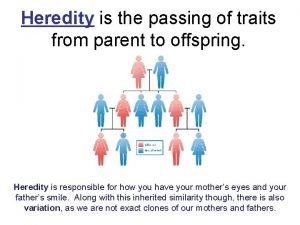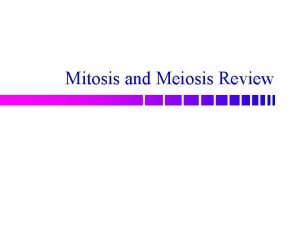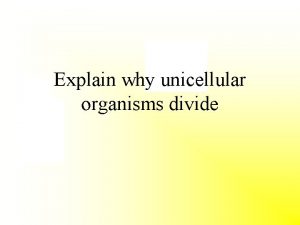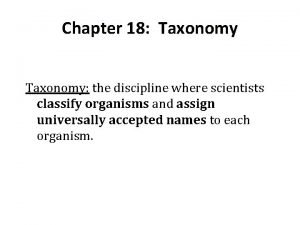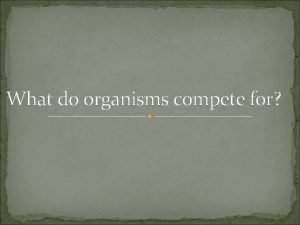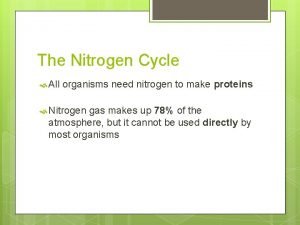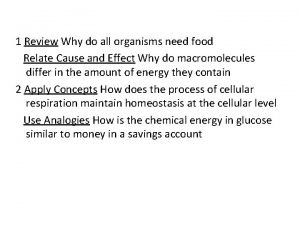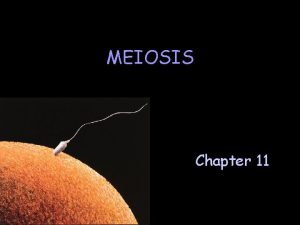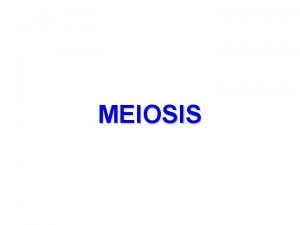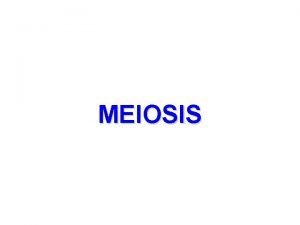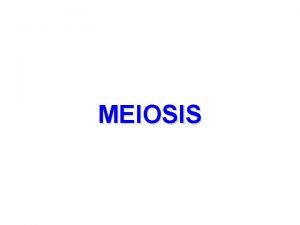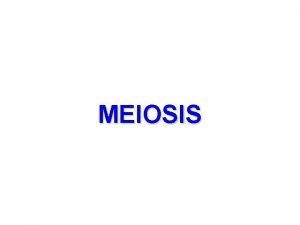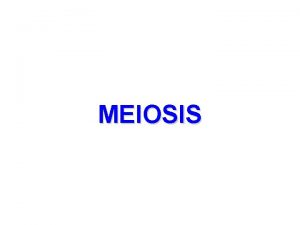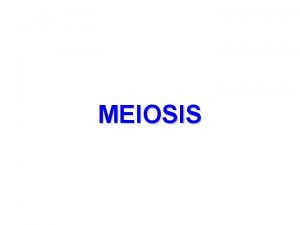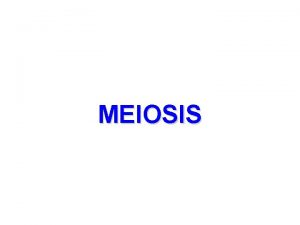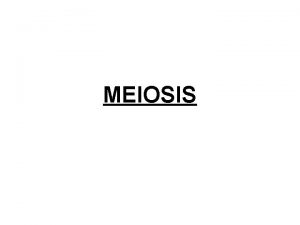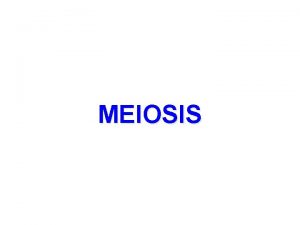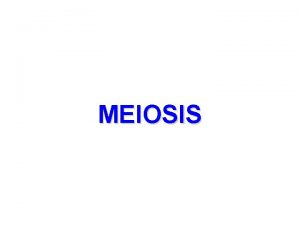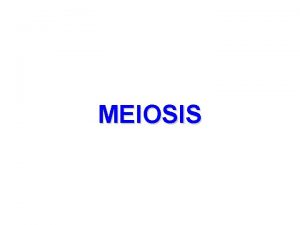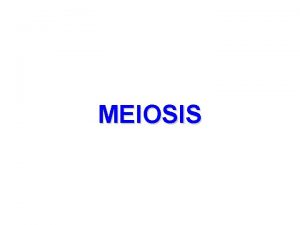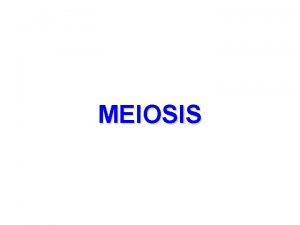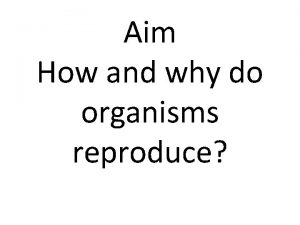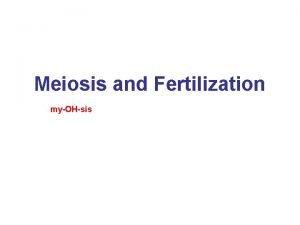MEIOSIS Chapter 9 Why must organisms reproduce A









![] Metaphase I F paired homologous chromosomes line up along equator of spindle ] Metaphase I F paired homologous chromosomes line up along equator of spindle](https://slidetodoc.com/presentation_image_h2/936467c13f5f58a45f443213a38b7a77/image-10.jpg)
![] Anaphase I F homologous chromosomes separate & move to opposite poles ] Anaphase I F homologous chromosomes separate & move to opposite poles](https://slidetodoc.com/presentation_image_h2/936467c13f5f58a45f443213a38b7a77/image-11.jpg)
![] Telophase I F spindle apparatus breaks down F chromosomes decondense F nuclear membranes ] Telophase I F spindle apparatus breaks down F chromosomes decondense F nuclear membranes](https://slidetodoc.com/presentation_image_h2/936467c13f5f58a45f443213a38b7a77/image-12.jpg)
![2. Meiosis II (equational division) ] Prophase II F chromosomes condense F spindle apparatus 2. Meiosis II (equational division) ] Prophase II F chromosomes condense F spindle apparatus](https://slidetodoc.com/presentation_image_h2/936467c13f5f58a45f443213a38b7a77/image-13.jpg)
![] Anaphase II F centromeres part; sister chromatids (now called chromosomes) separate & move ] Anaphase II F centromeres part; sister chromatids (now called chromosomes) separate & move](https://slidetodoc.com/presentation_image_h2/936467c13f5f58a45f443213a38b7a77/image-14.jpg)



![Structure of human sperm: ] Head F nucleus - 23 chromosomes F acrosome - Structure of human sperm: ] Head F nucleus - 23 chromosomes F acrosome -](https://slidetodoc.com/presentation_image_h2/936467c13f5f58a45f443213a38b7a77/image-18.jpg)


- Slides: 20

MEIOSIS Chapter 9

Why must organisms reproduce?

A. Types of Reproduction 1. Asexual Reproduction F involves only 1 parent F offspring are genetically identical to the parent (clones) F advantageous when organism is welladapted to a stable environment Ex. binary fission, parthenogenesis

2. Sexual Reproduction F involves 2 parents F parents produce haploid (1 n) gametes which fuse to form a diploid (2 n) zygote (first cell of offspring). F offspring are genetically diverse F advantageous in a changing environment Haploid gametes are produced by a type of cell division called meiosis.

B. Meiosis Type of cell division that halves the number of chromosomes. F involves 2 nuclear divisions (meiosis I & meiosis II) F 1 diploid (2 n) cell 4 haploid (1 n) cells F occurs in germ cells In humans, where would germ cells be located?

Germ cell replicates its chromosomes in S phase of interphase. 1. Meiosis I (reduction division) ] Prophase I F replicated chromosomes condense F spindle apparatus forms & fibers attach to chromosomes F nucleolus disappears F nuclear membrane breaks down F synapsis & crossing over occurs

Synapsis - homologous chromosomes (homologs) pair up. Homologs - chromosomes that carry genes for the same traits in the same sequence. A diploid human cell has 23 homologous pairs.

Crossing over - non sister chromatids of homologs exchange chromosomal material. Chiasma - visible point of cross over between homologs.

Animal cell in prophase I
![Metaphase I F paired homologous chromosomes line up along equator of spindle ] Metaphase I F paired homologous chromosomes line up along equator of spindle](https://slidetodoc.com/presentation_image_h2/936467c13f5f58a45f443213a38b7a77/image-10.jpg)
] Metaphase I F paired homologous chromosomes line up along equator of spindle
![Anaphase I F homologous chromosomes separate move to opposite poles ] Anaphase I F homologous chromosomes separate & move to opposite poles](https://slidetodoc.com/presentation_image_h2/936467c13f5f58a45f443213a38b7a77/image-11.jpg)
] Anaphase I F homologous chromosomes separate & move to opposite poles
![Telophase I F spindle apparatus breaks down F chromosomes decondense F nuclear membranes ] Telophase I F spindle apparatus breaks down F chromosomes decondense F nuclear membranes](https://slidetodoc.com/presentation_image_h2/936467c13f5f58a45f443213a38b7a77/image-12.jpg)
] Telophase I F spindle apparatus breaks down F chromosomes decondense F nuclear membranes partially reform around two nuclei Cytokinesis usually occurs between meiosis I & II
![2 Meiosis II equational division Prophase II F chromosomes condense F spindle apparatus 2. Meiosis II (equational division) ] Prophase II F chromosomes condense F spindle apparatus](https://slidetodoc.com/presentation_image_h2/936467c13f5f58a45f443213a38b7a77/image-13.jpg)
2. Meiosis II (equational division) ] Prophase II F chromosomes condense F spindle apparatus forms & fibers attach to chromosomes F nuclear membrane breaks down ] Metaphase II F chromosomes line up single-file along equator of spindle
![Anaphase II F centromeres part sister chromatids now called chromosomes separate move ] Anaphase II F centromeres part; sister chromatids (now called chromosomes) separate & move](https://slidetodoc.com/presentation_image_h2/936467c13f5f58a45f443213a38b7a77/image-14.jpg)
] Anaphase II F centromeres part; sister chromatids (now called chromosomes) separate & move toward opposite poles ] Telophase II F spindle apparatus breaks down F chromosomes de-condense F nuclear membranes reform F nucleoli reappear Cytokinesis divides two cells into four nonidentical cells.

Meiosis II Prophase II Metaphase II Anaphase II Telophase II Four nonidentical haploid cells


C. Gametogenesis in Humans 1. Spermatogenesis (meiosis in the )
![Structure of human sperm Head F nucleus 23 chromosomes F acrosome Structure of human sperm: ] Head F nucleus - 23 chromosomes F acrosome -](https://slidetodoc.com/presentation_image_h2/936467c13f5f58a45f443213a38b7a77/image-18.jpg)
Structure of human sperm: ] Head F nucleus - 23 chromosomes F acrosome - contains enzymes that help sperm penetrate egg ] Midpiece F mitochondria ] Tail

2. Oogenesis (meiosis in the )

Comparison of Oogenesis & Spermatogenesis
 Member of the same species
Member of the same species Examples of animals reproduce asexually
Examples of animals reproduce asexually Organisms that reproduce asexually
Organisms that reproduce asexually Meiosis has 8 main phases true or false
Meiosis has 8 main phases true or false Paint must never hope to reproduce the faint
Paint must never hope to reproduce the faint Concept mapping chapter 10 meiosis 1 and meiosis 2
Concept mapping chapter 10 meiosis 1 and meiosis 2 Chapter 10 meiosis 1 and meiosis 2
Chapter 10 meiosis 1 and meiosis 2 Chapter 10 meiosis 1 and meiosis 2 answer key
Chapter 10 meiosis 1 and meiosis 2 answer key Pictures
Pictures Unicellular and multicellular living things
Unicellular and multicellular living things Kelly reidell
Kelly reidell Meiosis 1 vs meiosis 2
Meiosis 1 vs meiosis 2 What is the difference between mitosis and meiosis 2
What is the difference between mitosis and meiosis 2 Telophase
Telophase Dont ask
Dont ask He must become greater; i must become less
He must become greater; i must become less Why do unicellular organisms divide
Why do unicellular organisms divide Why do scientists classify organisms?
Why do scientists classify organisms? Why do organisms compete
Why do organisms compete Why do organisms need nitrogen?
Why do organisms need nitrogen? Why do all organisms need food
Why do all organisms need food


